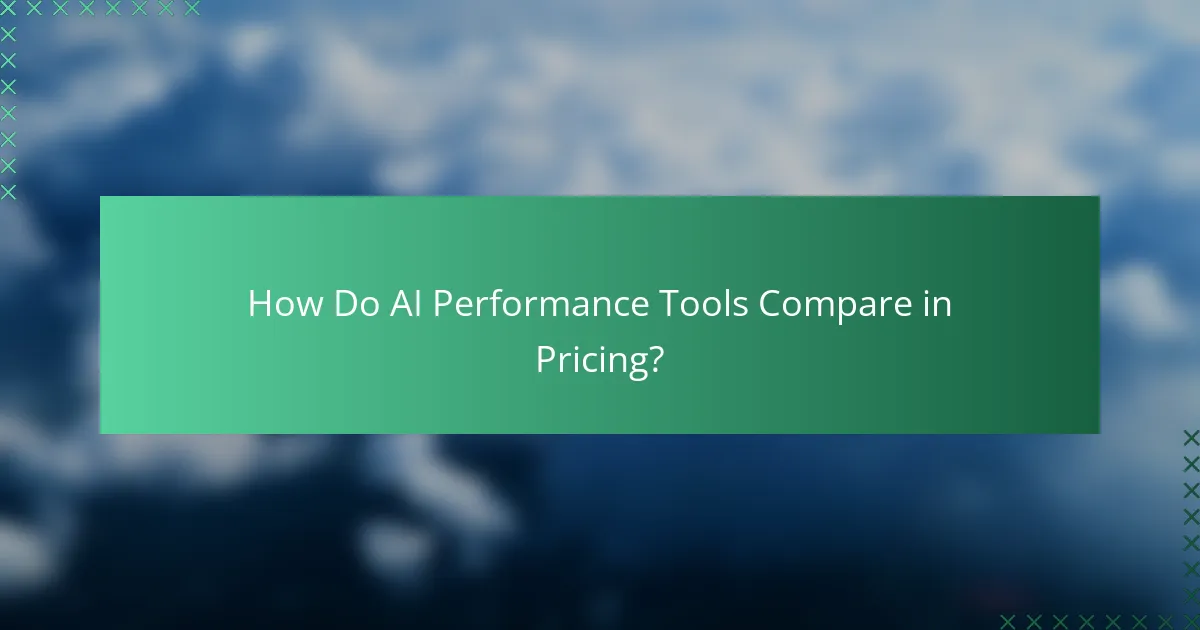AI performance tools are essential for organizations seeking to enhance data analysis, improve decision-making, and increase operational efficiency. When selecting the right tool, it is crucial to consider specific business needs, integration capabilities, and user-friendliness to ensure alignment with operational goals. By leveraging the right features, such as real-time analytics and customizable dashboards, businesses can optimize processes and drive growth effectively.

What Are the Key Benefits of AI Performance Tools?
AI performance tools offer significant advantages, including enhanced data analysis, improved decision-making, increased operational efficiency, cost savings, and scalability. These benefits help organizations leverage data-driven insights to optimize processes and drive growth.
Enhanced data analysis
AI performance tools improve data analysis by automating the collection and processing of large datasets. They can identify patterns and trends that may not be immediately visible to human analysts, allowing for deeper insights.
For example, a retail company might use AI to analyze customer purchasing behavior, leading to more effective marketing strategies. This capability can reduce analysis time from weeks to just a few hours.
Improved decision-making
With AI performance tools, organizations can make faster and more informed decisions. These tools provide real-time data insights, enabling decision-makers to react promptly to market changes or operational challenges.
For instance, in finance, AI can analyze market conditions and suggest optimal investment strategies, improving the likelihood of favorable outcomes. This shift from intuition-based to data-driven decision-making enhances overall business performance.
Increased operational efficiency
AI performance tools streamline operations by automating repetitive tasks and optimizing workflows. This leads to reduced human error and frees up staff to focus on higher-value activities.
For example, in manufacturing, AI can predict equipment failures and schedule maintenance proactively, minimizing downtime and enhancing productivity. Companies often see efficiency gains of 20-30% after implementing such tools.
Cost savings
Implementing AI performance tools can lead to significant cost savings by reducing labor costs and improving resource allocation. Automation of routine tasks allows businesses to operate with fewer personnel while maintaining output quality.
Additionally, AI can help identify wasteful spending or inefficient processes, allowing organizations to reallocate resources more effectively. Many companies report savings in the range of 10-25% after adopting AI solutions.
Scalability
AI performance tools enable organizations to scale their operations more effectively. As businesses grow, these tools can handle increased data volumes and complexity without a proportional increase in resources.
For example, a tech startup can use AI to manage customer support inquiries, allowing it to serve thousands of customers simultaneously without needing to hire additional staff. This scalability is crucial for maintaining service quality during rapid growth phases.

How to Select the Right AI Performance Tool?
Selecting the right AI performance tool involves understanding your specific business needs, evaluating integration capabilities, assessing user-friendliness, and considering vendor support. These factors ensure that the chosen tool aligns with your operational goals and enhances overall performance.
Identify specific business needs
Begin by clearly defining the objectives you want to achieve with an AI performance tool. Consider whether you need improvements in data analysis, customer engagement, or operational efficiency. This clarity will guide your selection process.
For instance, if your primary goal is to enhance customer service, look for tools that specialize in natural language processing and chatbots. Conversely, if data analytics is your focus, prioritize tools that offer robust data visualization and reporting features.
Evaluate integration capabilities
Integration capabilities are crucial for ensuring that the AI performance tool works seamlessly with your existing systems. Check if the tool can connect with your current software, such as CRM or ERP systems, and whether it supports APIs for custom integrations.
Tools that offer pre-built integrations with popular platforms can save time and reduce implementation costs. Aim for solutions that provide flexibility in integration to accommodate future system upgrades or changes.
Assess user-friendliness
User-friendliness is vital for ensuring that your team can effectively utilize the AI performance tool. Look for intuitive interfaces and accessible features that require minimal training. A tool that is easy to navigate will encourage adoption among users.
Consider conducting trials or demos to evaluate the user experience. Gather feedback from team members to understand their comfort level with the tool and identify any potential barriers to use.
Consider vendor support
Vendor support can significantly impact your experience with an AI performance tool. Investigate the level of customer service offered, including availability of technical support, training resources, and community forums. Strong vendor support can help resolve issues quickly and enhance your overall satisfaction.
Additionally, check for user reviews and testimonials regarding the vendor’s responsiveness and reliability. A vendor with a solid reputation for support can be a valuable partner in your AI initiatives.

What Features Should AI Performance Tools Have?
AI performance tools should include features that enhance data analysis, visualization, and collaboration. Key functionalities like real-time analytics, customizable dashboards, predictive modeling, and collaboration tools are essential for maximizing efficiency and insights.
Real-time analytics
Real-time analytics allows users to monitor data as it happens, providing immediate insights into performance metrics. This feature is crucial for businesses that need to make quick decisions based on current data trends.
When selecting a tool, look for capabilities that support low-latency data processing, enabling updates in seconds or minutes. Ensure the tool can integrate with existing data sources to provide a comprehensive view of performance metrics.
Customizable dashboards
Customizable dashboards enable users to tailor their data visualization to meet specific needs. This flexibility allows stakeholders to focus on the most relevant metrics and KPIs for their roles.
Consider tools that offer drag-and-drop functionality and a variety of widgets for displaying data. A good dashboard should allow users to save layouts and share them easily with team members, enhancing collaboration.
Predictive modeling
Predictive modeling uses historical data to forecast future outcomes, helping organizations anticipate trends and make proactive decisions. This feature is particularly valuable in sectors like finance and marketing, where understanding future behavior can drive strategic initiatives.
Look for tools that offer machine learning algorithms and user-friendly interfaces for building and testing models. Ensure that the tool can handle various data types and provides clear visualizations of predictions and their confidence levels.
Collaboration tools
Collaboration tools facilitate communication and teamwork among users, making it easier to share insights and findings. Features such as comments, notifications, and shared reports enhance the collaborative experience.
Choose tools that integrate with popular communication platforms and allow for real-time sharing of dashboards and reports. This ensures that all team members are aligned and can contribute to data-driven discussions effectively.

How Do AI Performance Tools Compare in Pricing?
AI performance tools vary significantly in pricing, with options ranging from subscription models to one-time purchases. Understanding these pricing structures helps users choose the best tool for their needs and budget.
Subscription models
Subscription models typically charge users a recurring fee, which can be monthly or annually. This approach often includes regular updates and support, making it appealing for businesses that require ongoing access to the latest features.
Prices for subscription plans can range from around $10 to several hundred dollars per month, depending on the tool’s capabilities and the scale of usage. Users should consider their long-term needs and whether they prefer predictable costs or flexibility in scaling.
One-time purchase options
One-time purchase options allow users to pay a single fee for lifetime access to the software. This can be advantageous for those who want to avoid ongoing costs and prefer to own the tool outright.
However, one-time purchases may not include future updates or support, which could lead to additional costs later. Prices for these tools often range from $50 to several thousand dollars, depending on the complexity and features offered.
Free trials and freemium versions
Many AI performance tools offer free trials or freemium versions, allowing users to test the software before committing financially. Free trials typically last from a week to a month, providing access to full features.
Freemium versions offer limited functionality at no cost, which can be useful for individuals or small teams with basic needs. Users should evaluate whether the free options meet their requirements or if they will need to upgrade for more advanced features.

What Are the Challenges in Implementing AI Performance Tools?
Implementing AI performance tools presents several challenges that organizations must navigate to ensure successful integration. Key issues include data privacy concerns, compatibility with existing systems, and the need for employee training.
Data privacy concerns
Data privacy is a significant challenge when implementing AI performance tools, as these systems often require access to sensitive information. Organizations must ensure compliance with regulations such as GDPR in Europe or CCPA in California, which mandate strict data handling and user consent protocols.
To address these concerns, companies should conduct thorough risk assessments and implement robust data protection measures. This may include anonymizing data, using encryption, and regularly auditing data access to prevent breaches.
Integration with existing systems
Integrating AI performance tools with existing systems can be complex, as compatibility issues may arise. Organizations should evaluate their current infrastructure and identify potential gaps that could hinder seamless integration.
It is advisable to choose AI tools that offer APIs or are designed for interoperability with popular platforms. Conducting a pilot program can also help identify integration challenges before full-scale implementation.
Employee training requirements
Employee training is crucial for the successful adoption of AI performance tools, as staff must understand how to use these systems effectively. Organizations should assess the current skill levels of their employees and provide targeted training programs to bridge any knowledge gaps.
Training can take various forms, including workshops, online courses, or hands-on sessions. Ensuring that employees are comfortable with the tools will enhance productivity and reduce resistance to change.
